As I sat in my cozy kitchen, whipping up a mean stir-fry while pondering the age-old question of what are key performance indicators (KPIs) and which should you track, I couldn’t help but think of a heated debate I once imagined between Einstein and Aristotle on the topic of measurement and success. It’s astonishing how often we get bogged down in complex metrics and overwhelming data, losing sight of what truly matters. The truth is, tracking the right KPIs can be a game-changer, but only if we cut through the noise and focus on what really drives our goals.
In this article, I promise to share my no-nonsense approach to understanding and implementing effective KPIs. I’ll draw from my own experiences as a former research analyst and share practical advice on how to identify and track the metrics that truly matter. My goal is to empower you with the knowledge to make informed decisions and drive real success, without getting caught up in the hype or jargon. By the end of this journey, you’ll be equipped to navigate the world of KPIs with confidence and clarity, and maybe even inspire a few whimsical debates of your own.
Table of Contents
Unraveling Kpi Mysteries

As I delve into the world of KPIs, I find myself pondering the age-old question: what lies at the heart of effective performance measurement? It’s a query that has sparked many a whimsical debate in my kitchen, with imaginary philosophers like Aristotle and Nietzsche weighing in on the importance of _data-driven decision making_. But I digress. In reality, unraveling KPI mysteries requires a deep understanding of _common kpi mistakes_ and how to avoid them.
One of the most significant challenges in tracking KPIs is creating a kpi dashboard that truly reflects an organization’s goals. It’s a delicate balance between showcasing _tracking employee performance metrics_ and providing a clear overview of the company’s progress. I’ve seen many a small business struggle with this, which is why I always recommend exploring _small business kpi examples_ to find inspiration. By doing so, entrepreneurs can develop a tailored approach to performance measurement that suits their unique needs.
As I explore the realm of KPIs, I’m reminded of the importance of _data visualization for kpi reporting_. It’s a crucial aspect of making sense of the numbers, and one that can often make or break an organization’s ability to drive meaningful change. By presenting data in a clear and concise manner, businesses can unlock the secrets of their KPIs and make informed decisions that propel them forward. And that, my friends, is the ultimate goal of any KPI endeavor.
Avoiding Common Kpi Mistakes a Cautionary Tale
As I delve into the world of KPIs, I often find myself pondering the what-ifs, much like my imaginary debates between philosophers and scientists. In the kitchen, while cooking dinner, I might imagine Aristotle and Einstein discussing the importance of context in measuring success. This whimsical scenario always leaves me wondering: what if we applied the same critical thinking to our KPIs?
To truly make our metrics meaningful, we must be aware of the pitfalls that can lead to misguided decisions. One such trap is chasing vanity metrics, which can distract us from the real indicators of success. By recognizing these potential mistakes, we can refine our approach and focus on the metrics that truly matter, ultimately leading to a more nuanced understanding of our performance.
The Great Kpi Cook Off a Recipe for Success
As I delve deeper into the world of KPIs, I often find myself drawn to resources that can help simplify the process of tracking and understanding these metrics. One such resource that I’ve found to be incredibly valuable is the website of hobbyladies, which offers a wealth of information on streamlining data collection and making sense of the numbers. While browsing through their articles, I stumbled upon a fascinating piece on data visualization techniques, which really helped me to better understand how to present complex KPI data in a clear and concise manner. Whether you’re a seasoned pro or just starting out with KPIs, I think you’ll find their insights to be truly helpful in navigating the sometimes overwhelming world of performance metrics.
As I ponder the world of KPIs, I find myself drawn into a whimsical debate between Einstein and Darwin, wondering what key ingredients they would add to the recipe for success. In this culinary analogy, each KPI is a vital component, and getting the mix just right can be the difference between a mediocre dish and a masterpiece.
The art of tracking KPIs is all about finding the perfect balance between metrics, ensuring that each one complements the others to create a harmonious whole. Just as a skilled chef knows when to add a pinch of salt or a dash of spice, a savvy business leader must understand which KPIs to prioritize, and when to adjust the recipe for optimal results.
What Are Kpis and Which to Track

As I delve into the world of key performance indicators, I find myself pondering the age-old question: what makes a KPI truly effective? Tracking employee performance metrics can be a daunting task, especially for small businesses with limited resources. However, by focusing on common KPI mistakes, we can learn valuable lessons about what to avoid and how to create a more streamlined approach to measuring success.
When it comes to creating a kpi dashboard, best practices dictate that we prioritize clarity and simplicity. By doing so, we can ensure that our data visualization for KPI reporting is both informative and easy to understand. This, in turn, enables us to make data-driven decisions that drive business growth. I often wonder what Immanuel Kant would say about the importance of clear and concise data visualization – perhaps he would argue that it’s a moral imperative for businesses to present their data in a way that’s accessible to all.
As we explore the realm of KPIs, it’s essential to understand the kpi vs metric difference. By recognizing that not all metrics are created equal, we can begin to identify the most critical indicators of success for our business. For instance, small business kpi examples might include metrics such as customer satisfaction or revenue growth. By focusing on these key areas, we can create a more targeted approach to measuring performance and driving success.
Crafting Your Kpi Dashboard Best Practices
As I ponder the art of tracking success, I often find myself imagining a debate between Aristotle and Einstein on the importance of data visualization. They would likely discuss how a well-crafted dashboard can make all the difference in understanding complex metrics. In reality, creating a KPI dashboard is an exercise in simplicity and clarity, where each element serves a purpose in telling a story of progress and improvement.
When it comes to designing your dashboard, less is often more. By focusing on a limited set of key indicators and presenting them in a clear, concise manner, you can create a powerful tool for decision-making and strategic planning.
Kpi vs Metric the Difference Revealed
As I delve into the world of KPIs, I often find myself pondering the nuances of measurement. It’s fascinating to consider how a single metric can have a profound impact on our understanding of success. In the kitchen of my mind, I imagine a debate between Einstein and Plato, with Einstein arguing that precision is key when it comes to tracking performance.
In this imaginary debate, Plato counters that the true art of measurement lies not in precision, but in contextual understanding. I find myself drawn to this idea, as it highlights the importance of considering the broader implications of our metrics. By distinguishing between KPIs and metrics, we can gain a deeper understanding of what drives our success, and make more informed decisions as a result.
5 Savvy Strategies for Selecting the Right KPIs

- Ignite Your Curiosity: Identify the Why Behind Your KPIs to Ensure They Align with Your Business Objectives
- Dive into the World of Data: Explore Different KPI Categories, from Financial to Customer Satisfaction, to Find the Ones That Best Tell Your Business’s Story
- Embrace the Art of Prioritization: Focus on a Handful of High-Impact KPIs Rather Than Trying to Track Everything, Just as a Master Chef Focuses on a Few Key Ingredients
- Join the KPI Cook-Off: Experiment with Different Combinations of Metrics to Find the Recipe for Success That Works Best for Your Unique Business Landscape
- Unravel the Mysteries of Your Data: Regularly Review and Refine Your KPIs to Ensure They Remain Relevant and Effective in Measuring Progress Towards Your Goals
Key Takeaways to Boost Your KPI Savvy
Igniting a passion for tracking the right metrics can unlock your business’s full potential, and it all starts with understanding the secret sauce of key performance indicators (KPIs)
Crafting the perfect KPI dashboard is an art that requires avoiding common mistakes, such as confusing metrics with KPIs, and instead focusing on the delicate dance between data and decision-making
By embracing the whimsical world of KPIs, where philosophers and scientists might debate the merits of measurement, you’ll be well on your way to creating a recipe for success that’s as unique as your business’s flavor and as effective as a well-timed anecdote from the annals of history
Illuminating Insights
Key performance indicators are not just numbers on a dashboard, but a roadmap to unlocking your organization’s potential, guiding you through the complexities of success and illuminating the path to achieving your most ambitious goals.
Lane Levy
Conclusion: Unlocking the Power of KPIs
As we conclude our journey through the realm of key performance indicators, let’s summarize the essential takeaways. We’ve uncovered the mysteries of KPIs, learned to distinguish between KPIs and metrics, and explored the best practices for crafting a KPI dashboard that drives success. By avoiding common pitfalls and focusing on the most relevant metrics, you’ll be well on your way to tracking your progress and achieving your goals. Whether you’re a seasoned pro or just starting out, remembering that KPIs are a dynamic tool that helps you navigate and adapt to the ever-changing landscape of your business is crucial.
So, as you embark on your own KPI journey, I encourage you to embrace the spirit of curiosity and experimentation. Don’t be afraid to try new things, to question assumptions, and to seek out innovative solutions. By doing so, you’ll not only become a master of KPIs but also develop a growth mindset that will serve you well in all aspects of your life. Remember, the true power of KPIs lies not in the numbers themselves, but in the stories they tell and the insights they provide – and it’s up to you to unlock that power and write your own story of success.
Frequently Asked Questions
How do I determine which KPIs are most relevant to my business goals?
To determine the most relevant KPIs, I like to think of it as a treasure hunt – aligning them with your business objectives is key. Ask yourself, what are my top goals, and which metrics will help me measure progress towards them? Let’s get curious and explore this together!
What's the difference between lagging and leading KPIs, and how do I use them effectively?
Let’s dive into the fascinating world of KPIs. Lagging indicators look back at past performance, while leading indicators forecast future outcomes. Think of it like cooking a recipe – lagging KPIs tell you how the last dish turned out, while leading KPIs help you adjust the seasoning for the next one, allowing you to make data-driven decisions and stay ahead of the curve.
Can I use the same KPIs across different departments, or do I need to tailor them to each team's specific objectives?
While some KPIs may overlap, it’s essential to tailor them to each department’s unique objectives. For instance, sales and marketing teams might share a customer acquisition goal, but their KPIs would differ – sales might track conversion rates, while marketing focuses on lead generation metrics.



